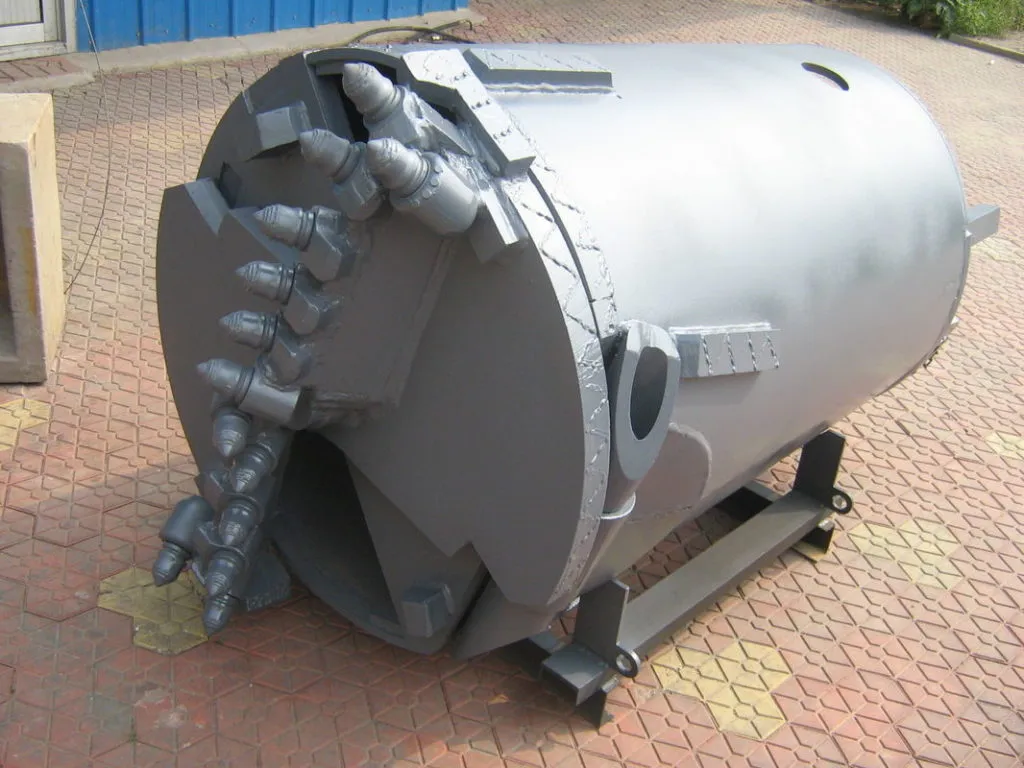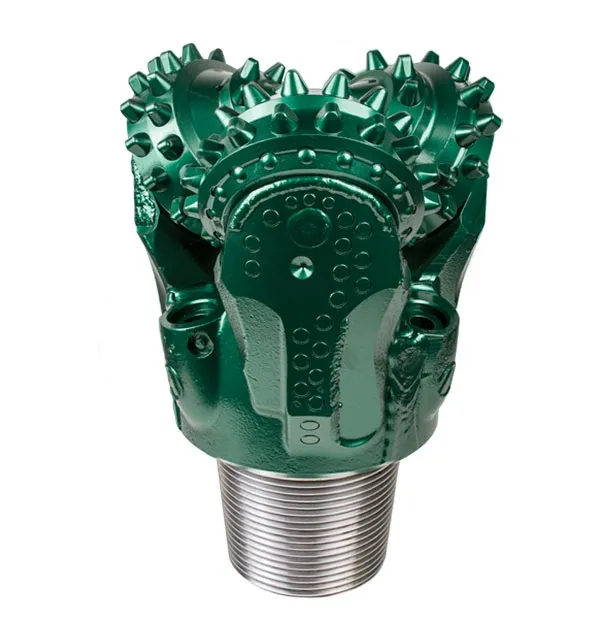A good structure or building starts with a good foundation, and a good foundation starts with pile driving service. Pile drilling tools enables this service. Foundations relying on driven piles often have groups of piles connected by a pile cap (a large concrete block into which the heads of the piles are embedded) to distribute loads which are larger than one pile can bear. Pile caps and isolated piles are typically connected with grade beams to tie the foundation elements together; lighter structural elements bear on the grade beams, while heavier elements bear directly on the pile cap.
In the drilled cavity a multitude of products can be created, e.g. by filling with fresh concrete a so-called cast-in-place pile is produced. Precast concrete and steel elements could serve as load-bearing or lining elements can also be inserted.
Different types of Pile drilling tools
Drilling tools improves working efficiency of the rotary drilling rigs. With different drilling tool, the piling machine is able to get the pile foundation work done in a wider range of construction projects whether it is in cities or fields. Some of them tools are given below.
Drilling bucket
Drilling buckets are used for drilling in cohesive and non-cohesive soil below groundwater level. Drilling buckets are suitable for breaking and ripping hard soil up to medium hard rock. Its design allows for a manual hand-operated, or automatic opening mechanism to be fitted (for emptying)- For drill rigs fitted with striker plate.

Bored piles
Bored piles, also known as replacement piles, are commonly-used forms of building foundation that provide support for structures, transferring their load to layers of soil or rock that have sufficient bearing capacity and suitable settlement characteristics. Bored piles are piles where the removal of spoil forms a hole for a reinforced concrete pile which is poured in situ. The spoil is replaced by the pile, hence ‘replacement’ piles as opposed to displacement piles where soil is forced away by driving or screwing the pile. Bored piles are used primarily in cohesive subsoils
for the formation of friction piles and when forming pile foundations close to existing buildings. They are popular in urban areas as there is minimal vibration, where headroom is limited, where there is no risk of heave, and if there is a need to vary the length of the piles.
An Auger
An auger or a bucket can be used to bore cohesion less soil or average compacted clay. An auger consists of a central shaft with a spiral shaped flange welded around it. The cutting edges of the helical flange have wedge-shaped teeth. Augers are suitable for digging clayey or cohesionless, dry soil. In fact, if there is groundwater, the excavated soil can often fall back into the hole as the tool is being lifted out.
Soil bucket
A bucket is made up of a hollow, cylindrical section fitted with a hatch on the bottom with a slit that is attached by a hinge to one end of the cylinder. Cutting teeth are welded onto the edge of the slit to help load the soil into the cylindrical bucket and also prevent it from falling out when the tool is withdrawn. Once the drilling tool has been brought to the surface, the hatch is unhooked from the bucket body and the soil is discharged. As it is a closed drilling tool, the bucket is ideal for digging loose, cohesion less soil or soft clay below the water table.

Rock auger
A rock auger or a core barrel can be used when boring highly compacted clay or rocky soil. A rock auger uses different cutting teeth compared to a traditional auger. The teeth on a rock auger are not wedge-shaped but conical (they are also called “bullet” teeth, as they look like the streamlined tip of a bullet) with a heavy-duty metal element inserted at the top. The teeth are also housed in supports to allow them to rotate around the axle; hence wear of the cutting tip is uniform. Rock augers are ideal for drilling highly compacted clay and soft or very weathered rocks.
Core barrel
A core barrel is basically a bucket without the hatch on the bottom, fitted with cutting teeth along the whole lower edge. Thanks to the special arrangement and configuration of the teeth (which can vary according to the hardness of the soil), once the rock core has entered the inner cylindrical assembly, it will not fall out as the barrel is being extracted.
Rock drilling bucket
Rock Drilling buckets are mainly used for drilling water-bearing sandy soil, sludge, clay, muddy sub clay, sandy gravel, cobble, and weathered soft formation. The bucket can be designed into cylindrical type and conical type according to bucket diameter, type of drilling rig and soil conditions. The opening and closing device can be operated manually, mechanically or mixed manner. The welding angle of bucket teeth can be designed according to formation conditions. The bottom cover is made of high-strength plate, and the cutting edge includes the single-layer type and double-layer type; The soil inlet also includes the single-bottom type and double-bottom type.

Post Hole Digger Earth Auger
Post Hole Digger Earth Auger is suitable for punching on land, frozen soil, and ice layer, and is widely used in gardens, planting, planting trees, geophysical exploration, road construction, etc. The drill is made of manganese steel synthetic, and is harder, adapting to working on hard soil, super hard soil, clay, frozen soil, etc. It can select drills of varied specifications according to tree species to meet the user’s needs. It frees people from heavy manual labor, is widely used in planting trees, planting fruit forest, the fence, and fruit trees fertilization in autumn, etc, and is suitable for all kinds of terrain, high efficiency, easy to carry and field operation. It can be operated by a single man as well as double persons, economic and practical.
Kelly bars
Kelly bars are key components in the execution of boreholes with hydraulic rotary drilling rigs. They transfer the torque of the rotary drive and the crowd pressure of the crowd system concurrently to the drilling tool. Kelly bars are key components in the execution of boreholes with hydraulic rotary drilling rigs. They transfer the torque of the rotary drive and the crowd pressure of the crowd system concurrently to the drilling tool. A Kelly bar consists of 2 – 5 telescopic tubular sections with a system of drive keys and lock recesses, welded onto their outer surfaces.
Cross cutter
Cutting ring with rock drilling bits and releases the internal stress of rock, while cutting inside,
Crossing cutter makes it easy to carry soil, when drilling in the full fracture rock layer. Applicable layers are Gravel soil, highly weathered rock, and medium weathered rock. It is also suitable for drilling hard, jointed rock and for penetrating through layers containing boulders.
Tremie pipe
A tremie is a watertight pipe, usually of about 250mm inside diameter (150 to 300 mm),[1] with a conical hopper at its upper end above the water level. It may have a loose plug or a valve at the bottom end. A tremie is used to pour concrete underwater in a way that avoids washout of cement from the mix due to turbulent water contact with the concrete while it is flowing. This produces a more reliable strength of the product.
The tremie is often supported by a working platform above the water level. The pipe is made up of short sections commonly joined by screw thread with O-ring seal so that the length can be adjusted during the pour without getting the top of the pipe below the water or removing the bottom end from below the surface of the poured concrete.
Roller Bits
Roller Bits are manufactured in compliance with industrial standards of quality by making use of the best raw materials. These roller bits are available to clients at extremely reasonable market prices in various sizes. These are commonly used wear parts which find application in drilling tools. These roller bits are easy to install and have minimal maintenance needs. These are suitable for rugged use.

Drilling and casing
Drilling and casing operations accelerate well construction, reduce risk exposure, and mitigate potential hazards. Using our drilling-with-casing (DwC) or drilling-with-liner (DwL) systems, you can drill, ream, run, set, and cement your casing or liners in a single trip. The bits enable casing drilling across soft, medium and hard rock formations. And, they can be drilled out with the planned BHA, which eliminates the need for dedicated drill out trips. The bit design includes a selectable blade count and configurable cutter size to suit your formation type and application. Mounted on the face of the tool, the polycrystalline-diamond-compact cutters maximize drilling efficiency and durability.
Casing Adapter
A casing adapter is a circular mechanism used when the casing is a smaller, or in rare cases larger, diameter than the diameter of the casing pusher. The casing adapter is designed to provide lateral as well as axial support to the steel casing that is being driven into place. Like the casing, the casing adapter is also made of steel in order to withstand the force of pipe jacking and the like, and to resist the internal and external forces on the casing.
Casing shoe
In oil drilling and borehole mining, a casing shoe or guide shoe is a bull-nose shaped device which is attached to the bottom of the casing string. A casing hanger, which allows the casing to be suspended from the wellhead, is attached to the top of the casing. Once preliminary shoe depths are selected, sensitivity checks are required to validate the degree of operating kick tolerances that exist. Kick tolerances are defined as the maximum kick size that can be safely circulated out of the well via the subsea choke line without fracturing the weakest exposed wellbore formation.
Conclusion
There are a variety of products which are employed for pile during construction. Choosing the one that serves your need is the key here. You can also convert JPG to PDF with PDF Software .The design, installation and quality assurance that are a part of each driven pile combine to eliminate guesswork and produce a known, reliable and cost-effective product to its client that can accommodate a wide variety of subsurface conditions.You can also convert JPG to PDF with PDF Software .



